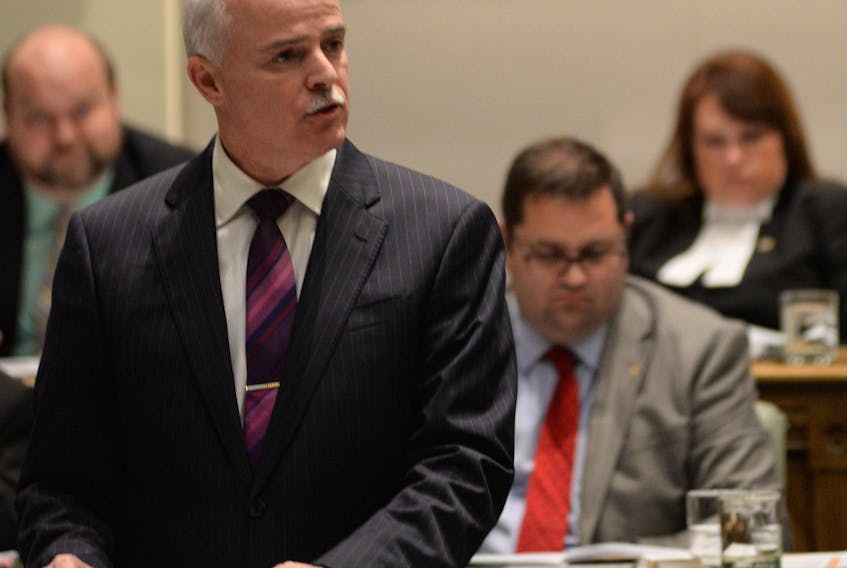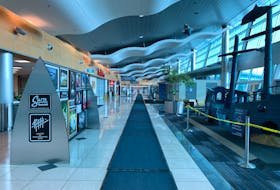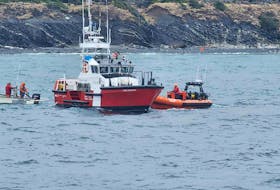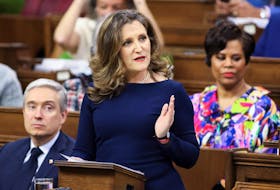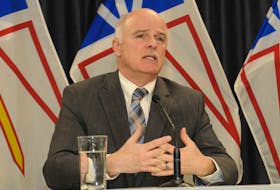ST. JOHN'S, N.L. — These days, Finance Minister Tom Osborne has a favourite saying: “A tree takes time to take root and takes time to bear fruit.”
It’s something he said Monday, following the release of a report on economic diversification in the province from McKinsey and Co. It was also something he said Tuesday, speaking about the latest provincial budget.
The minister, and the Liberal government as a whole, has been criticized for not aggressively reducing government spending, and for allowing the province to continue to borrow.
But Osborne insists the Liberals are doing what needs to be done.
“In government departments we are spending less. We do have initiatives there to diversify the economy and I’m actually proud of that,” he said, when challenged on the level of government spending, just before giving his speech.
He regularly touts the Liberals’ reduction in the province’s annual deficit ($522 million in 2018-19) and reductions in the size of the public service, without mass layoffs.

Spending with economic diversification in mind, he said, creates jobs, creates opportunities that attract newcomers and helps to bring back people who once lived here. And he thinks the Liberals are doing a better job at those targeted, diversification efforts than past governments.
His budget speech made specific mention of businesses such as Hi-Point Industries in Bishop’s Falls, S+P Data and Juniper BBQ Scraper Ltd., as examples of successes the province has helped.
“Through McKinsey’s analysis it was identified that greater investment attraction efforts can spur the growth of individual sectors such as supply and services in the aquaculture industry by injecting capital that might not be available for new projects,” he said in the House of Assembly, while announcing another $500,000 for investment attraction activities.
The announced budget included plenty more examples of “spending money to make money.” And there were repeat references to the recommendations from McKinsey, as Osborne mentioned a new Digital Ocean Centre of Excellence, geoscience initiatives and College of the North Atlantic training programs, for example.
If fully supporting the spending decisions, the hard reality faced by Osborne and future ministers is there is less ability to make such announcements in the future, every time the province borrows more today.
Critics continue to suggest more could be done in all aspects of government to reduce spending. And the longer changes aren’t made, the less money is available for things like targeted diversification or tax breaks, and the more is required for debt servicing.
“Some investments in high-tech sectors, aerospace, things that are going to be industries of the future are good to see, but I think no matter what, if it’s all built on an uncompetitive framework and an unsustainable framework in terms of our taxation system and how our government spends money, the debt that we’re accumulating — which is going to amount to future taxation — that is something that goes into any business decision as to whether you’re going to locate yourselves in Newfoundland and Labrador,” said Jaclyn Sullivan with the Newfoundland and Labrador Employers’ Council, following the minister’s speech Tuesday.
She said spending beyond your means crowds out your ability to even spend on things like health care and education. The budget of constraint grows. And it affects attractiveness.
“If we’re building these things on top of an uncompetitive and unsustainable framework, then they’re not going to be successful,” she said.
“If we’re building these things on top of an uncompetitive and unsustainable framework, then they’re not going to be successful." — Jaclyn Sullivan, N.L. Employers' Council
Sullivan acknowledged reductions in departmental spending, as Osborne described, but the council has been advocating for more aggressive action, for wholesale reform in how government programs and services are delivered.
“We haven’t seen a plan for that yet,” she said. “So that was disappointing.”
When it comes to spending, Osborne says there is a plan and there will be more benefit coming to the bottom line from things like ongoing digital improvements and shared services — seeds are planted and the tree is growing. There will be savings from further reductions in leased space, he suggested. After dropping the number of government vehicles by about 10 per cent last year, there will be continuation of that, he said.
He has argued cuts, or the suggestion of deep cuts, risk a shock to the economy at the worst possible time — as the government continues to wait for more oil money and pursues other paths to return to surplus in 2022-23.
But Osborne also now faces the challenge of responding to the need to rapidly make Newfoundland and Labrador an attractive province for business. McKinsey’s report lays out many areas where new spending could help with economic diversification and job growth.
As for choosing when to cut, when to spend and when to save?
“It’s not easy,” he said.
And if the price of oil drops like a stone or skyrockets … well, that’s a whole other issue.
RELATED
- BUDGET 2019: Waterford Hospital replacement work continues
- BUDGET 2019: Liberal election budget highlights Atlantic Accord
- BUDGET 2019: A little of this, a little of that for Newfoundland and Labrador consumers
- BUDGET 2019: Opposing views on energy, taxes for Newfoundland and Labrador
- BUDGET 2019: Funding for ArtsNL, 50+ Clubs, Ocean tech
- BUDGET 2019: What’s to like and what’s not to like

